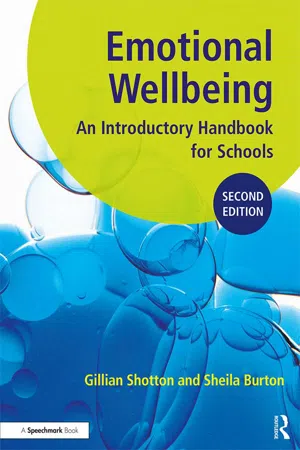As we entered the 21st century, central government initiatives focused more broadly on children’s wellbeing. The Children Act 2004 (Every Child Matters) emphasised five priority outcomes for children:
The National Healthy Schools Programme had from 1998 already recognised the important contribution schools make to children’s general wellbeing, including emotional health. As part of the Primary National Strategy a suggested emotional literacy curriculum covering school years R to 6 was published by the Department for Education and Skills in 2005. Entitled ‘Social and Emotional Aspects of Learning’ (SEAL), it incorporated activities and supporting materials to enable class teachers to cover key topics in a developmental way year on year.
Changes of government led to changed priorities and the emphasis once more was narrowed to academic achievement. However, with increasing economic pressures following the global financial crash of 2008 and subsequent austerity measures, aimed at reducing the annual budget deficit, there then arose mounting concern over deteriorating mental health statistics for children and young people. Children and Adolescent Mental Health Services faced a crisis in funding. A growing number of children are receiving diagnoses of ‘neurodevelopmental disorders’, particularly autism and attention deficit hyperactivity disorder, and it seems the scarce resources are focused much more heavily on diagnosis rather than treatment. Schools have looked to health services to intervene, yet in many places they are offering very little more than pharmaceutical intervention. There is a scarcity of therapeutic intervention beyond drug therapies.
By necessity, the focus has moved to school-based intervention such as school counselling, parenting support provided by school-based staff, and emotional wellbeing support for pupils, delivered by school staff such as learning mentors and emotional literacy support assistants (ELSAs). The rapidly growing ELSA work will be discussed more fully in a subsequent section of this introduction. It was out of this work that the first edition of ‘Emotional Wellbeing: an introductory handbook’ was written to support those staff in schools that provide support to emotionally vulnerable children. A decade on, this second edition entitled ‘Emotional Wellbeing: an introductory handbook for schools’ expands upon the original publication with many new sections. It reflects additions to the original ELSA training which have been widely implemented by educational psychology services that provide this training and supervision programme to schools. The content is applicable to all kinds of school professionals that support vulnerable children and adolescents, as well as to those working with them outside the school environment.
Maslow’s hierarchy of needs
One of the most popular and often quoted theories of human motivation was developed by Abraham Maslow and first published in 1943. He looked at motivation within the context of a hierarchy of human needs. Initially Maslow identified five levels of need.
He referred to the lower four levels as deficiency needs which must be satisfied before we can act unselfishly. When they are met, higher needs emerge and become the focus of interest. When, however, we experience stressful conditions, or find ourselves under threat, we regress to a lower need level.
Physiological needs
Our most basic level of need is for air, water, food and sleep. If these needs are not met we may experience irritation, discomfort, pain or sickness. Such feelings motivate us to establish what is known as homeostasis – a state of balance where the needs have been satisfied. Once these basic deficiencies are alleviated we are able to think about higher level needs.
Safety needs
At the next level our concern is to establish stability and consistency in our personal world. We need to feel safe, not only physically but also psychologically.
Love needs
We all have the need to be loved and to receive affection from others. We are social beings and our sense of identity comes partly from belonging to a group. We therefore need to experience the acceptance of others.
Esteem needs
Esteem needs fall into two categories – self-esteem and esteem from others. The former arises from feelings of competency as well as specific achievements. The latter relates to our need to be appreciated and admired. It is more than just being accepted within a group; we desire the approval and affirmation of others. The extent to which we perceive ourselves to be valued by others affects our sense of self worth.
Self-actualisation
Self-actualisation is not described by Maslow as a deficiency need but a being need. It is the desire to make the most of our potential and become everything we are capable of becoming.
Maslow later refined his hierarchy by adding three further levels (Maslow and Lowery 1998). Cognitive then aesthetic needs precede self-actualisation, which is followed by a higher level of self-transcendence.
It is only when the deficiency needs are satisfied that we are motivated to seek knowledge for its own sake. We develop a desire for greater understanding of the world in which we live. Aesthetic needs are about appreciating symmetry, order and beauty within that world. The level of self-transcendence moves beyond personal fulfilment into a need to connect with something that exists beyond our self, or it may be about helping others to realise their potential. These needs may be considered to be a search for spiritual satisfaction.
Choice theory, developed by William Glasser (1998), shares much in common with Maslow’s hierarchy of needs while also stating a need for fun and enjoyment. He rejects the psychology of external control for a psychology that focuses on sustaining the relationships that lead to healthy, productive lives. According to Glasser, almost all behavior is chosen, and we are driven by our genes to satisfy five basic needs: survival, love and belonging, power, freedom and fun. We choose all our actions and thoughts, and indirectly almost all our feelings and much of our physiology. He suggests that much of what goes on in our body is the indirect result of the actions and thoughts we choose. Glasser offers choice theory as a non-controlling psychology that gives the freedom to sustain relationships that lead to healthy, productive lives. Rather than blaming others for our behavior, choice theory invites us to accept personal responsibility for the choices we make.
Emotional literacy
Much is written these days about emotional intelligence or emotional literacy. Salovey and Mayer (1990) were the first psychologists to make a specific link between emotional and cognitive aspects of intelligence. In education the term emotional literacy tends to be preferred because it breaks away from the notion of a fixed, underlying level of intelligence that cannot be significantly altered. Emotional literacy, by contrast, can be nurtured and developed throughout life. Peter Sharp (2001) defined emotionally literate people as those who are ‘able to recognise, understand, handle and appropriately express their emotions’. We need to recognise the emotions we experience so that we can define them. As we develop an emotional vocabulary we are enabled to put our feelings into words. Without the language to communicate their feelings, children are reliant upon communicating through their behaviours. This may be through what we describe as ‘acting out’ behaviours, which present as overtly challenging and, if appropriate help is not provided, often lead to school exclusion. Other children, however, may become withdrawn in response to emotional distress; the greater risk for them is of their needs being overlooked because their behaviour is unthreatening to others. Emotional understanding is important if we are to learn from our experiences and develop resilience. Being able to manage our emotions allows us to build and maintain healthy relationships with others. As we learn to express our emotions in appropriate ways, we help both ourselves and other people, since an equally important aspect of emotional literacy is recognising, understanding and responding appropriately to the emotional states of others. These dual aspects may be referred to as intrapersonal skills (managing own emotions) and interpersonal skills (managing social interactions).
The importance of emotional wellbeing is receiving greater attention at all levels of education – government, local authority and school – and there are now many published books and resources, available through educational suppliers, that promote active support within school for children’s emotional development.
There will always be some children in our schools whose ability to learn is adversely affected by emotional and psychological difficulties. If we give them the chance to think about these difficulties within the context of a relationship that is supportive and safe, we can help them become more resilient in the face of adversity. As they feel better able to recognise and manage their feelings, they will engage more readily with the learning challenges presented to them in school.





